 The movie is a Horn of plenty—of sticky historical issues. 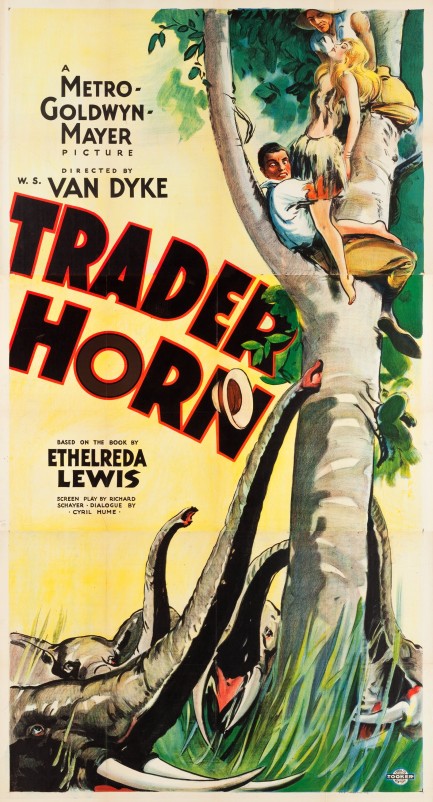
Trader Horn is an Academy Award nominated movie adapted from the real life African adventures of the explorer Alfred Aloysius “Trader” Horn, and as a major production has many high quality posters. The one above is our favorite, but all the promos are impressive, as you'll see when we share some a little later. Trader Horn is an archetypal white goddess movie—which is to say, a group of intrepid adventurers encounter a white woman reigning over an African tribe. Obviously, Hollywood took a bit of creative license with Horn's biographical writings. At least, we assume so. Harry Carey plays Horn, an old hand on the Dark Continent, whose aplomb in the face of danger is nothing short of Richard B. Riddickesque: “The good Lord only gives us one death to die and a fellow musn't bungle it.”
On the other side of the emotional spectrum is the white goddess, played with pre-Hays Code abandon by a half-clad Edwina Booth. The central thrust of the plot is Horn's efforts to return Booth to the modern world. That's standard for the white goddess sub-genre. What isn't standard is Trader Horn's location shooting in the places known back then as the Terrritory of Tanganyika, the Protectorate of Uganda, Kenya Colony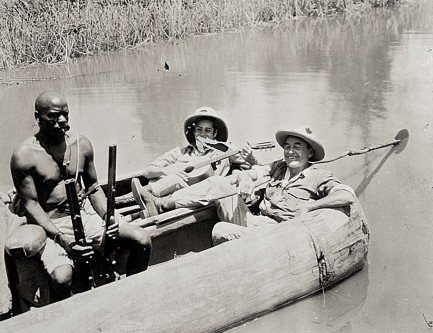 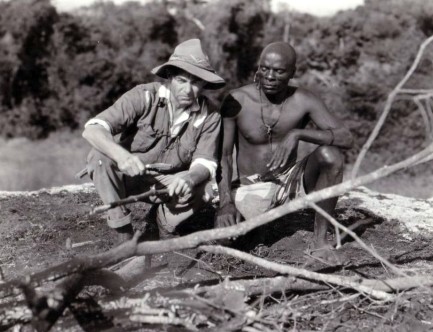 Anglo-Egyptian Sudan, and the Belgian Congo. The expenduture must have been enormous, but the money shows—vividly. You won't be surprised to learn that people died making the film—one by being consumed by a crocodile, and the other by being trampled by a rhino. There were also numerous illnesses and accidents. And... it was all worth it! Just kidding. Thoughts and prayers. Anglo-Egyptian Sudan, and the Belgian Congo. The expenduture must have been enormous, but the money shows—vividly. You won't be surprised to learn that people died making the film—one by being consumed by a crocodile, and the other by being trampled by a rhino. There were also numerous illnesses and accidents. And... it was all worth it! Just kidding. Thoughts and prayers.
We don't have to get into specifics on the movie's plot. There isn't much of one. It's more of a narrated travelogue than a linear story. Even so, it's a massive production well worth seeing. Obviously, old movies usually have their issues, none more so than old movies set in Africa. But if you go in with the right attitude they can be fun. For example, anytime a white character says something about how savage Africans are, just add to the end of the line of dialogue something like: “Says the guy from the race that invented flame throwers and the electric chair.” Also, take a drink (optional). The subsequent occasion an awful generalization is made about Africans, come up with two more horribly savage things whites invented. You'll never run out. Best pair from our screening: “Says the guy from the race that invented the Spanish Donkey and pension clawbacks.”
Look, here's the thing—it can be a good idea to keep it light when it comes to ninety-year-old movies that touch on race, sort of the way it can be a good idea to laugh it off when your grandfather tells you that during his miliary service he once went to Tokyo on shore leave and found the Japanese to be, “an inscrutable little people.” You can't change him, so you save your valuable anger for when you'll really need it, like when you go to Florida, where racism officially doesn't exist. In Trader Horn's defense, it may have been—like your grandpa—fairly liberal for the period. Kenyan castmember and Masai chieftain Mutia Omoolu gets at least a dozen lines of dialogue. We bet he didn't get paid union scale, though. Actually, the SAG didn't exist until 1933, but you get the point. Omoolu and fellow Kenyan performer Riano Tindama did, however, earn a trip to L.A. for reshoots, an event that occasioned some sensationalistic press coverage of a predictable nature.
We've wandered far afield. Let's crank this careening post back onto the main roadway and ask: Is Trader Horn a good movie? Owing to its age, we obviously wouldn't go that far. But it's a tremendous spectacle, and serious film buffs should see it. The idea that actors were out there on the veldt shooting this stuff instead of in front of a green screen emoting opposite a volleyball on a stick is amazing. But that type of unfiltered filmmaking is possibly gone for good. For one thing it costs a fortune. And generally, the arc of cultural development tends toward more safety, whether physically, mentally, professionally, or whatever. Beyond a doubt, certain things are lost along the way. Visceral cinematic realism comes to mind. But on the other hand, it's good for people not to be eaten by reptiles or contract schistosomiasis. Watch the movie and see what you think. It premiered in the U.S. today in 1931. 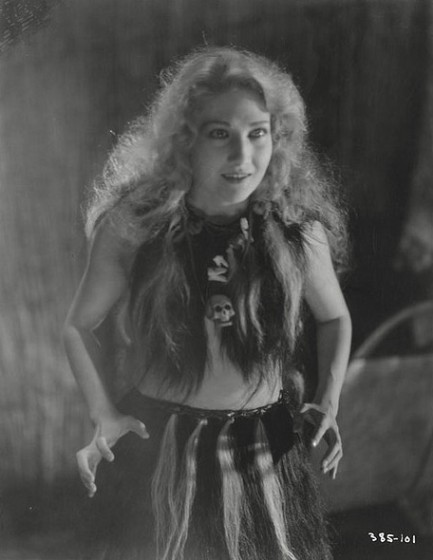 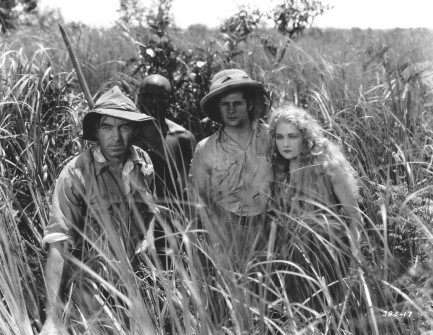 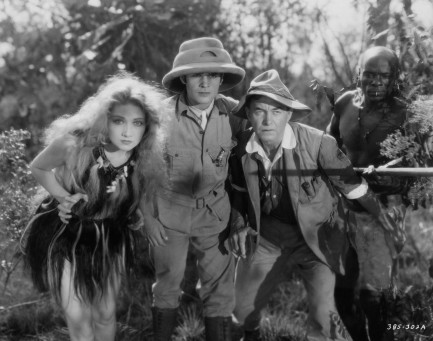 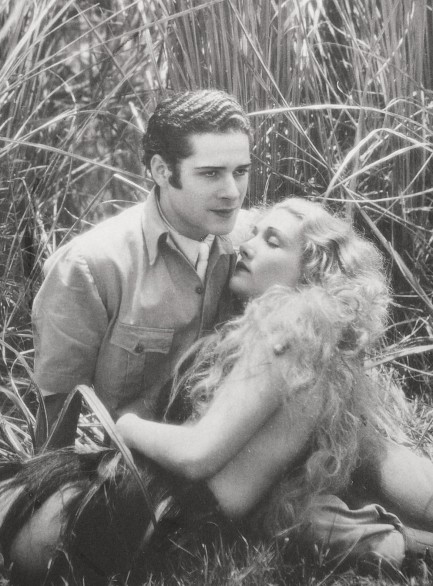 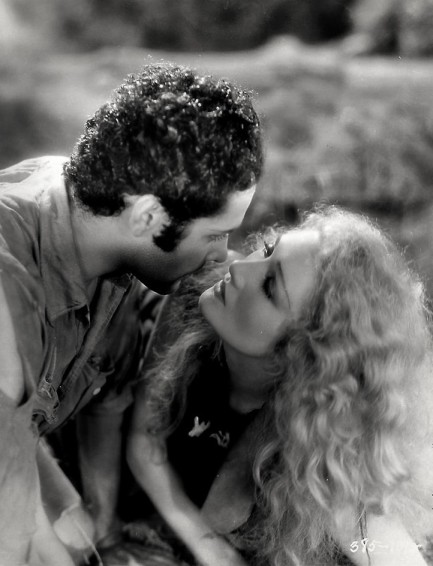 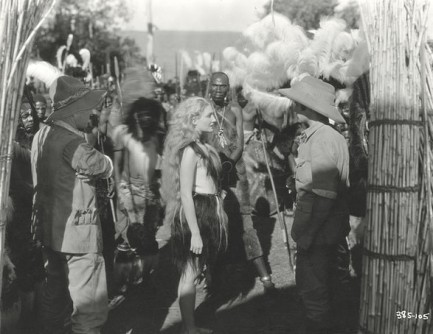 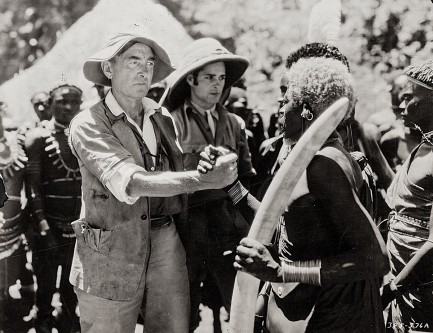 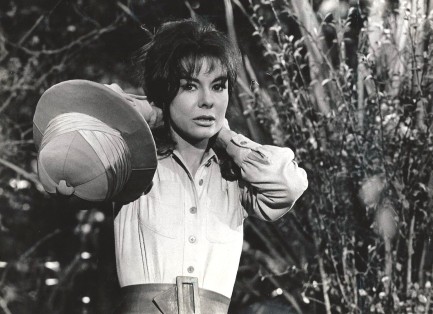 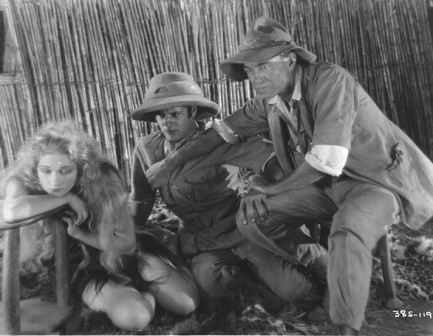 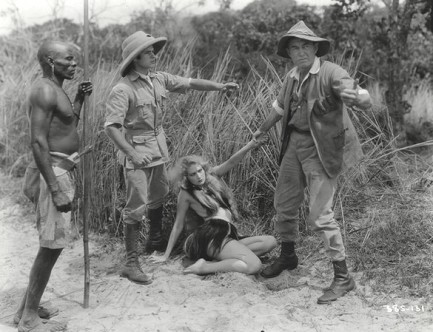 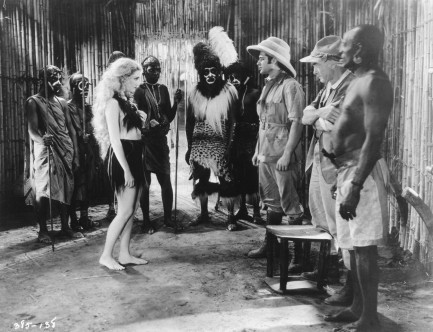  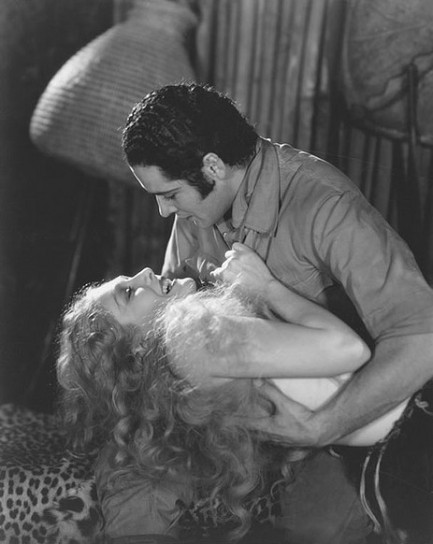 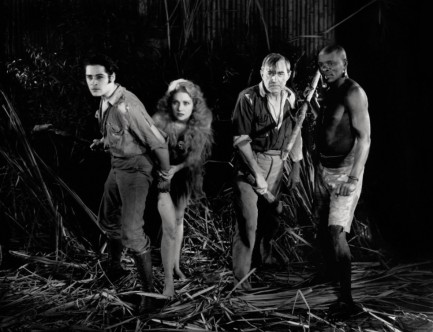 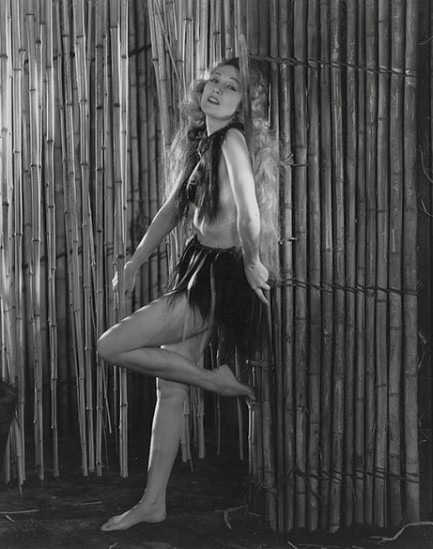 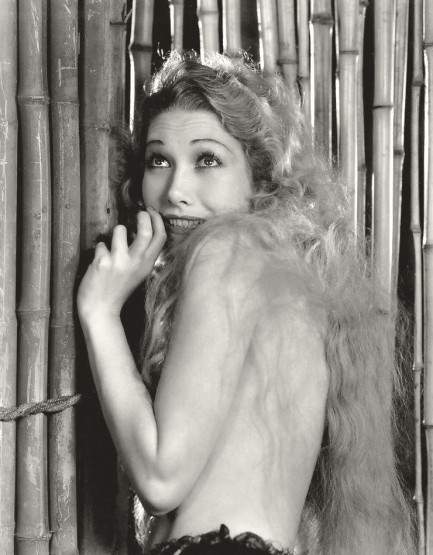 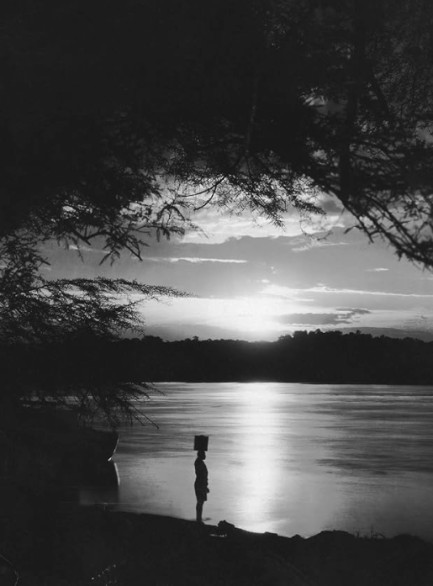
 Toto we’re not in Africa anymore. 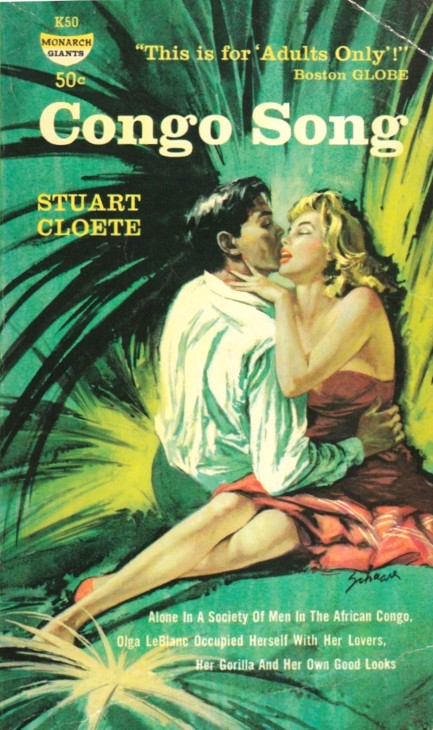
We said we'd get back to Stuart Cloete’s 1943 jungle drama Congo Song, and here we are. The book has been reprinted often, including in the 1958 Monarch edition you see above, with Harry Schaare cover art. Its popularity certainly owed something to the fact that it was another book that nurtured popular Western stereotypes about life in Africa, including that it attracted decadent and damaged whites whose weaknesses were inevitably amplified by the deep, dark, primitive, savage, mysterious continent. You've read something like this once or twice, we bet, thanks to Hemingway and others, though Cloete, who was from South Africa, writes in an entirely different style than Papa:
This was the Congo song: the song of sluggish rivers, of the mountains, the forests; the song of the distant, throbbing drums, of the ripe fruits falling, of the mosquitoes humming in the scented dusk; the song of Entobo, of the gorilla, and the snake. The song no white man would ever sing. The wild dogs cry out in the night as they grow restless, longing for some solitary company. Oops—that last sentence is from the Toto song “Africa.” Don't know how that slipped in there. Anyway, Congo Song unfolds in the months before the start of World War II. Cloete’s characters are diverse, with his main creation being Olga le Blanc, the only woman living in an isolated outpost called Botanical Station with several men, including her husband, a researcher who spends a lot of time away. Olga is a vamp who must make other men fall in with love her, and her affections don't end at homo sapiens sapiens—she has a gorilla, unsubtly named Congo, that she nursed at her own breast when it was an infant. Cloete’s symbolism is pretty thick milk. Erudite conversation, circular philosophizing, seductions, and secrets abound at Botanical Station. One of the other main characters is an American named Henry Wilson who has been sent by handlers in Nairobi to keep an eye on the doings of a German spy named Fritz von Brandt. Olga, meanwhile, spies on von Brandt for the English—sometimes from his bed. Other characters have less purpose, and many eccentricities. One drinks too much. Another sleeps with teenaged Congolese girls under the guise of employing them as domestics. The researcher seems to love trees more than Olga. Nobody is particularly happy. Who is who? Who wants what? There's another spy, who we won't name, a machine-like man, asexual, immune even to Olga: Women were the weakness of so many. Money, luxury, power, all resolved themselves finally into women. That was where the money went. That was what the power was used to obtain. How lucky he was to have been born without sexual feelings. All the duplicity in Congo Song derives from the looming war in Europe, but there's also another driver: “Under all this,” Olga observes, “is the never-ending fight for the riches of Africa.”
Despite all the dinners, safaris, subterfuges, and soliloquies—or maybe because of the soliloquies—the book doesn't gather momentum until about page two-fifty, after a fatal accident. Then things move fast enough to cause whiplash. Death comes by various methods, none of them banal. And of course there's still that gorilla. He lives in the house with the le Blancs, but Olga lets him loose regularly. Surely that'll end with limbs separated from bodies and blood on the louvered doors. And Cloete clearly must—absolutely must—squeeze in a little lethal witch-doctoring. No more plot hints. However, it isn't a spoiler to reveal that since Cloete follows the basic blueprint of other books of this type, at least a character or two eventually flee for modern civilization. But they'll remember Congo with bittersweet nostalgia—primarily during a maudlin denouement drawn out over several chapters. But it's understandable—it's not easy to let go of such beauty and horror. Not easy to let go of Congo Song either. It wasn't perfect, but it was very interesting. It’s gonna take a lot to take me awaaaay from yoooou… There’s nothing that a hundred men or moooore could ever doooo… I bless the rains down in Aaaafricaaa… 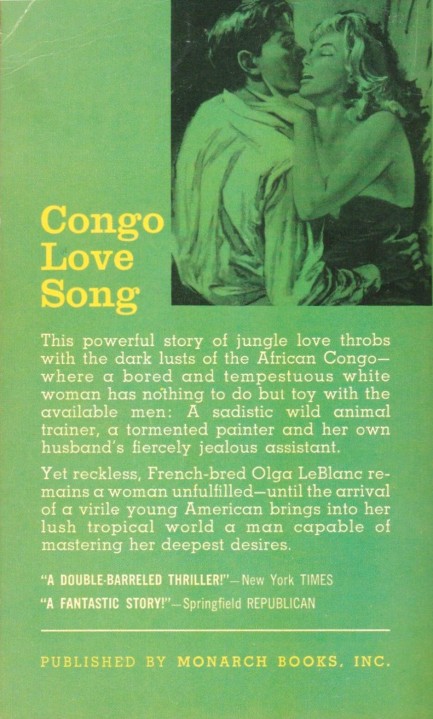
 She was worried about making friends here, but as you can see she's become pretty much the person to know. 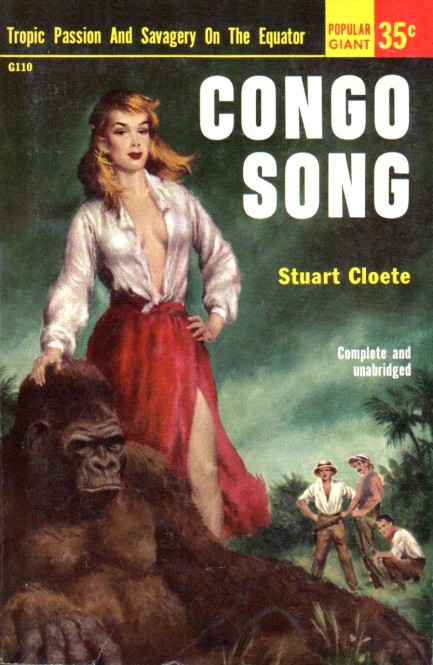
Above is a curious cover for Stuart Cloete's novel Congo Song, first published in 1943, with this Popular Giant version coming in 1952 fronted by excellent George Mayers cover art. This is a book we've kept our eyes on over the years. We finally bought it, but not this version. We have the 1958 Monarch Books edition with Harry Schaare cover art. We'll circle back to that later and tell you what it's all about. We expect sheer craziness.
 Mogambo features the cruelest beast in all of Africa—and its name is Clark Gable. 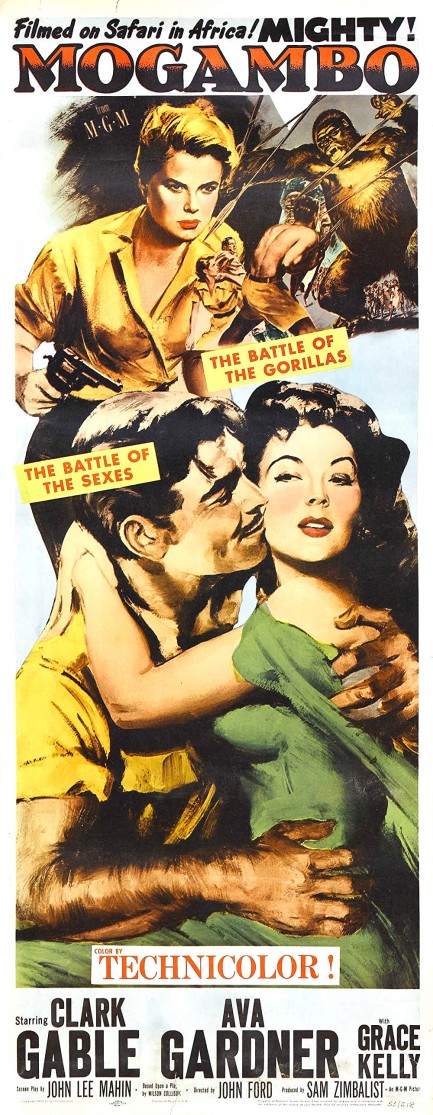
As famous as Mogambo is, we'd never seen it, had never read a review of it, and had no idea going in what it was about except that it was a safari movie and a remake of the 1932 adventure Red Dust, which we'd also never seen. There are few hit movies—especially with stars the stature of Clark Gable, Ava Gardner, and Grace Kelly—that we don't know at least a little something about. So we cleared the slate, cooked up some popcorn in our special Lindy's hand-cranked popper, and settled in for a screening.
Shot in Kenya, Uganda, French Equatorial Africa (now Central African Republic), and the Tanganyika region of what is now Democratic Republic of Congo, the movie is about a hard-edged safari guide and hunter played by Gable (also the star of Red Dust, by the way) who tries to score with both Gardner and Kelly, and soon has them at each other's throats. These old movies often work on the presumption that the male star is irresistible—period. As a result, screenwriters were sometimes lazy. They'd fail to write the male lead with any charm at all.
That holds true here, as Gable is gruff, rude, twenty years older than Gardner, and almost thirty years older than Kelly. We're fine about the age difference, unlike the “age appropriate” crowd that thinks women are capable of making any decision except ones about whom they love, but because Grant is a complete sourdough some charm would have made Gardner's and Kelly's attraction to him more understandable. Handsome though he may be, here he's nothing more than moustache, hair tonic, and bossiness. But okay, Gardner and Kelly are both in states of need, and Gable is more than happy to introduce them to his bush snake, so what you get is a love triangle folded inside a Technicolor safari adventure. Fine.
The production is spiced up with majestic scenery, nice costumes, realistic animal footage, an overwhelming feel of the exotic, the tantalizing implication of intimacy with two of the most beautiful women in cinema, and a deft, assured performance from Gardner. In fact, while Gable is top billed, Ava gets nearly all the good lines. “Listen, buster,” she scolds Clark, “you and your quick-change acts aren't gonna hang orange blossoms all over me just because you feel the cold weather coming on!” That's a scathing way to call someone old and desperate. But Gable has his moments too. We liked when he blustered, “You know how it is on safari. It's in all the books. The woman always falls for the white hunter and we guys make the most of it.” That's meta, so we hear.
Obviously, tribespeople figure prominently, and you can discern marginal improvement in their portrayal since the days of Weissmuller's Tarzan. They're still just ornamentation in their own lands, but at least none lay down their lives to save a white man who's spent most of his screen time cracking a whip at them. Whew. Overall, we thought Mogambo was decent. Not great, mind you—because Gable deserved to play a more nuanced character and did not have that chance—but it was decent. It premiered today in 1953.
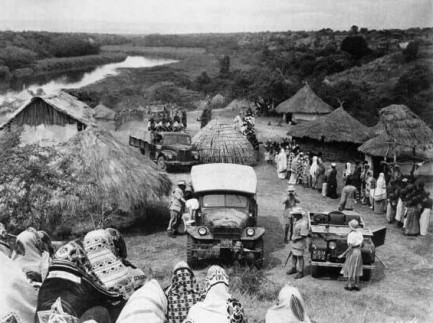 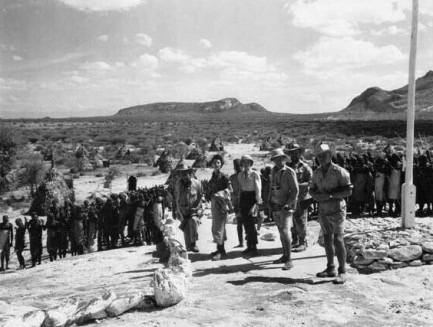 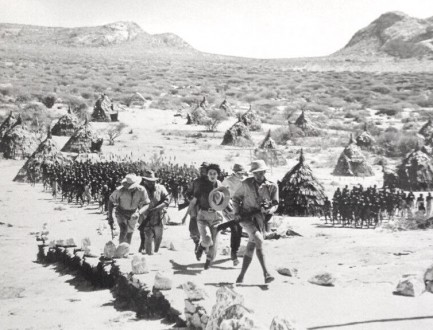 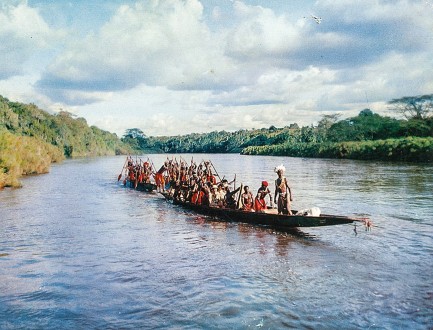 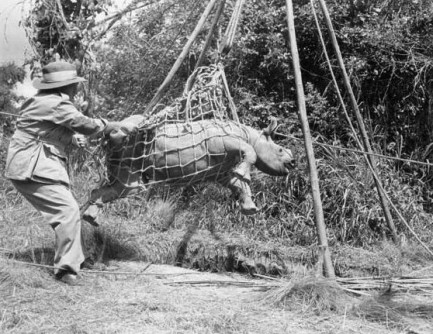 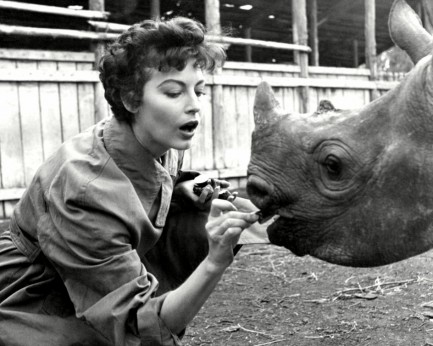 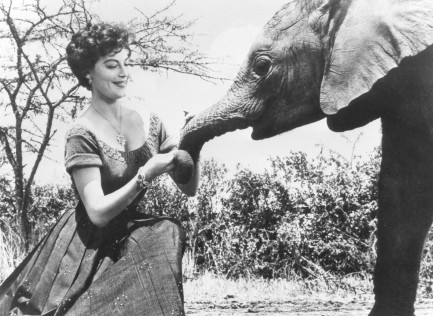 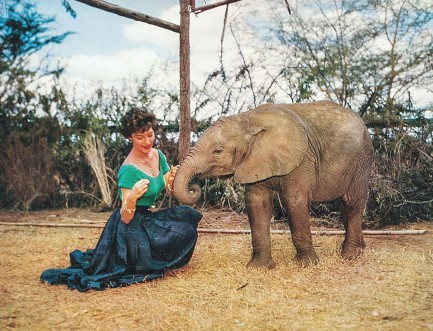 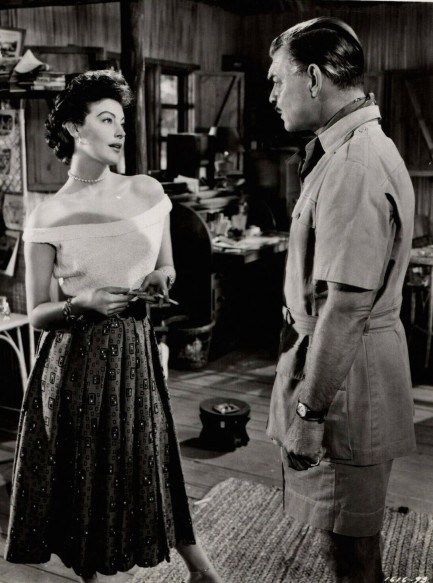 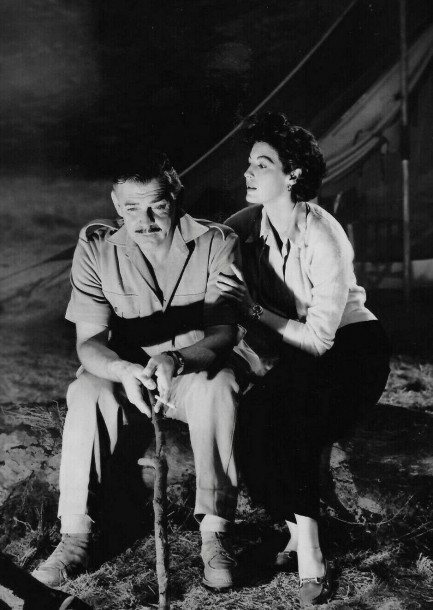 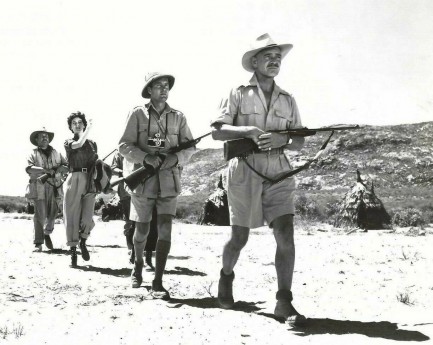 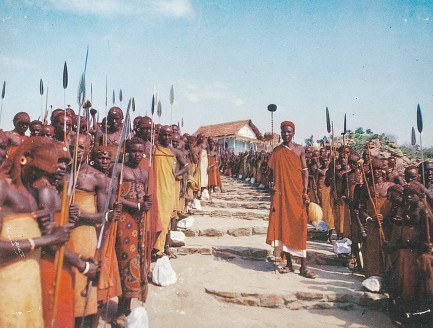 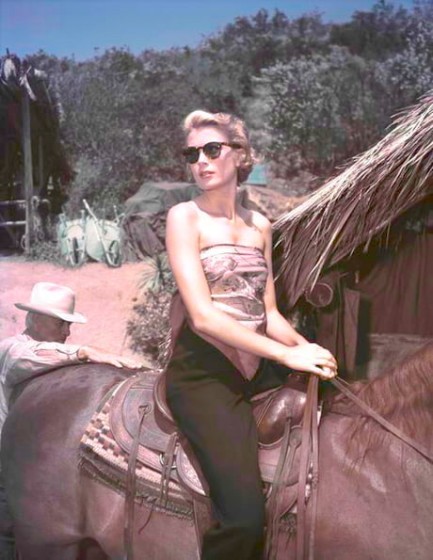 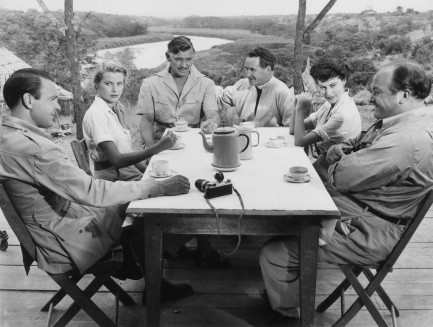 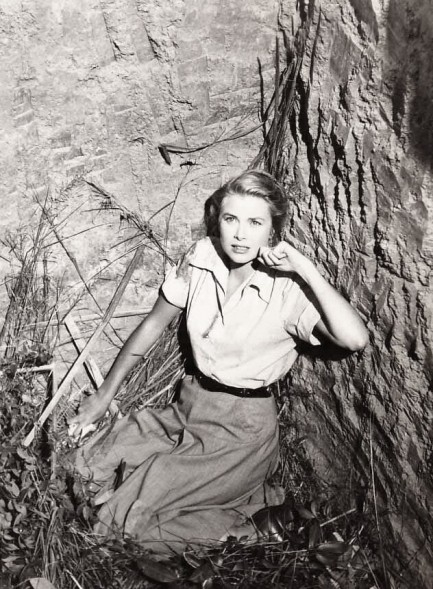 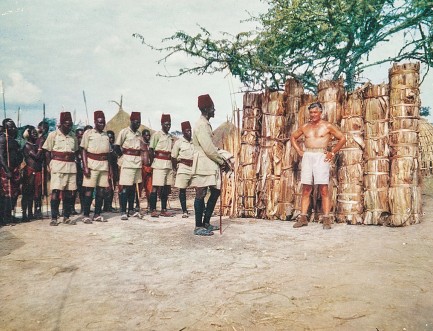 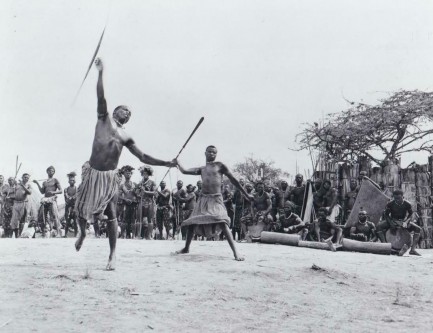 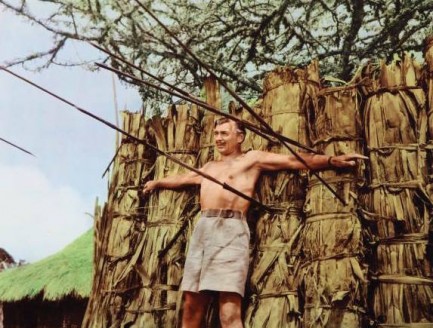 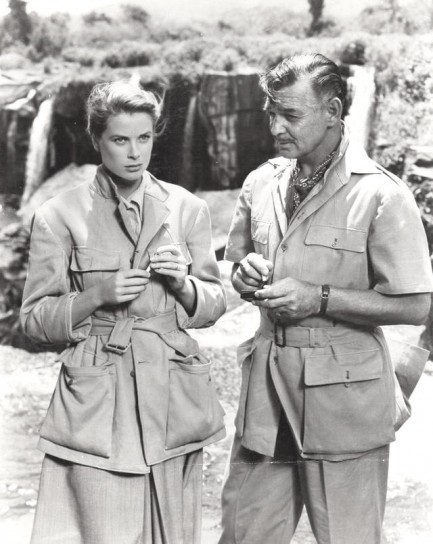 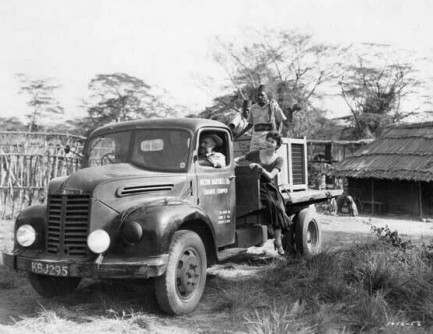 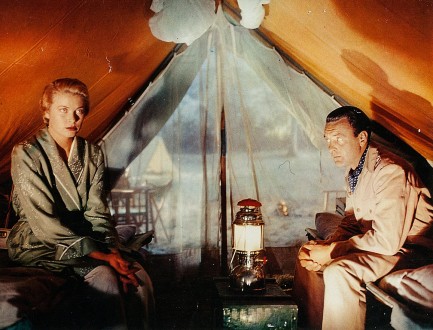 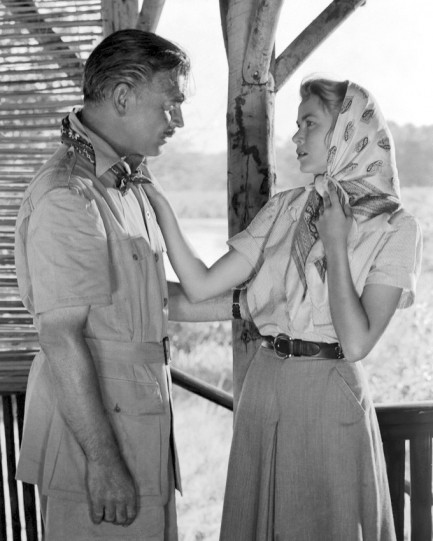 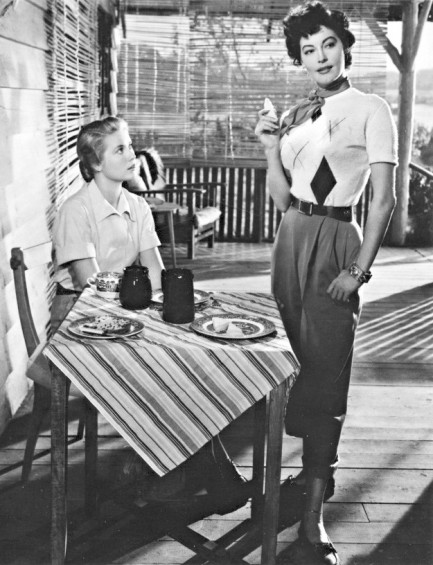 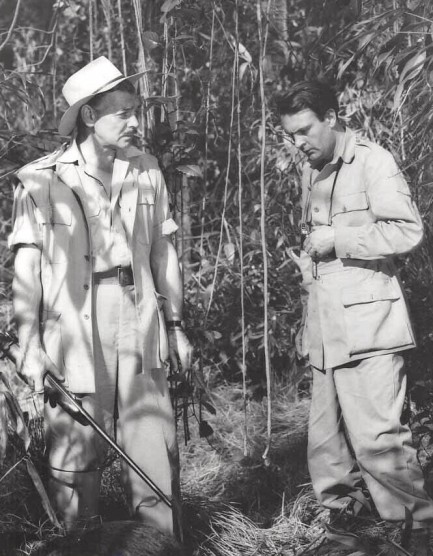 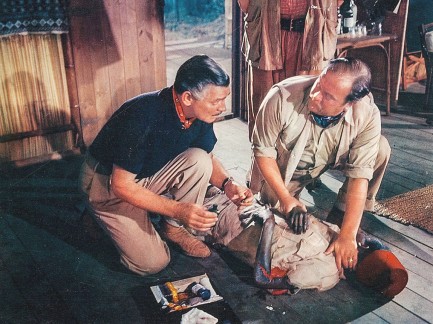 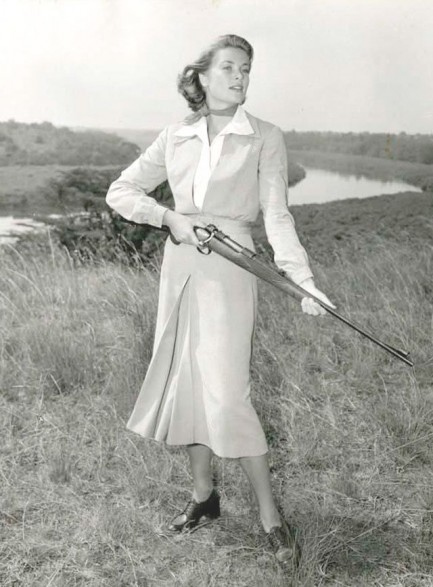 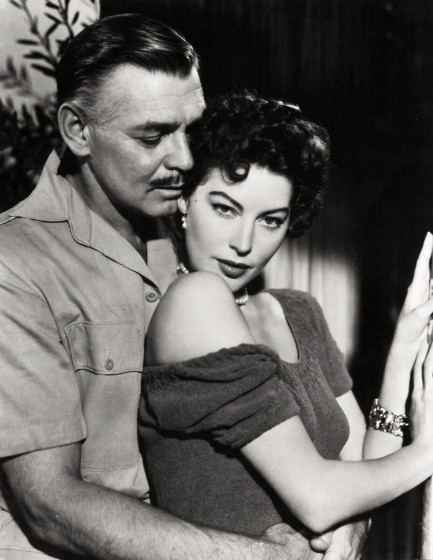  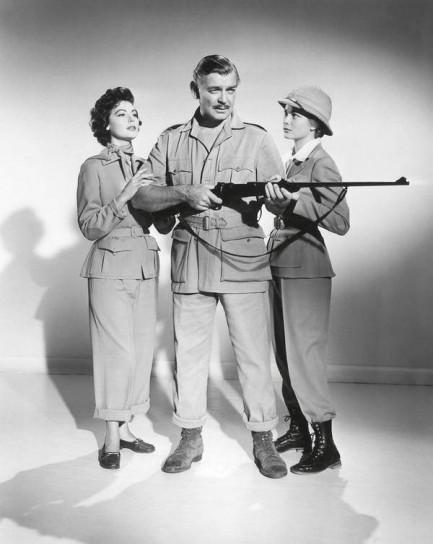 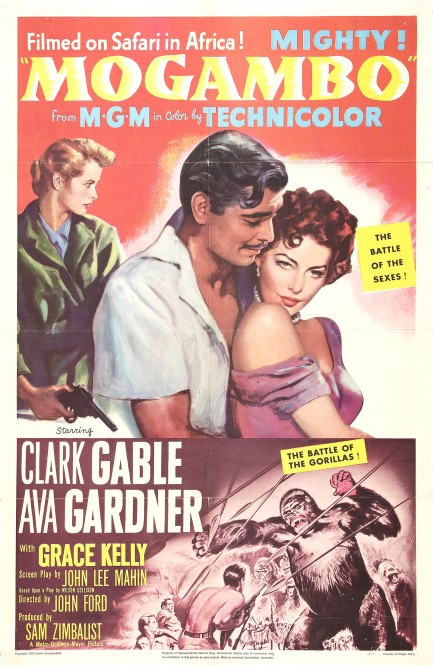
 Up the river and into trouble. 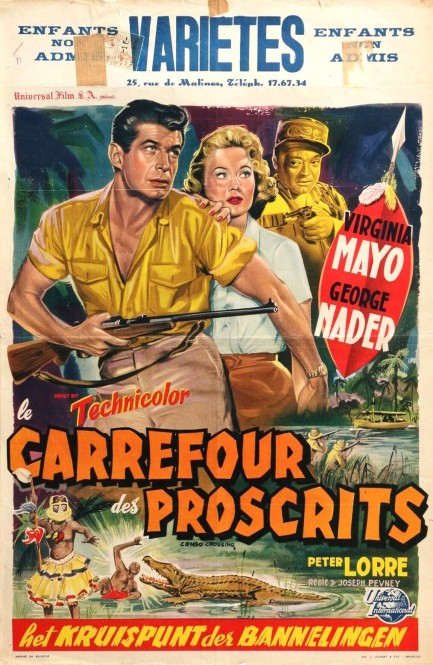
Vintage Belgian movie posters are generally very nice. This one was made for Congo Crossing, which was titled Carrefour des proscrits in French and Het Kruispunt der Bannelingen in Dutch. The movie isn't actually set in the Belgian Congo. Instead it takes place in a fictional west African territory called Kongotanga, where George Nader and Virginia Mayo find themselves snared in an adventure that's part Casablanca and part African Queen. Sounds good, right? You can read what we wrote about the film here. There's no premiere date for Belgium but it probably played there in the spring of 1957.
 Now that you've shot the continent's last white rhino can we do something I think is romantic? 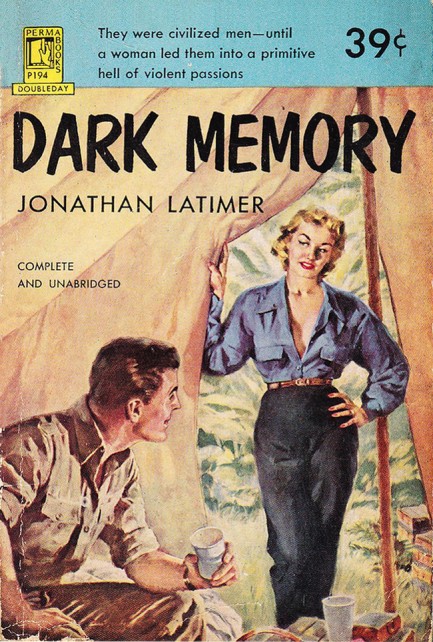
Jonathan Latimer's African adventure novel Dark Memory needs a more grandiose title, because it's pure Hemingway, and you know how lyrical his titles were. Latimer's novel is about nature, and courage, and women. It reads as if he said to himself after finishing Green Hills of Africa, “I wonder if I could do something like what Papa did here?” Well, he could. Dark Memory is a totally absorbing safari tale, a slice of time long gone. Latimer is in what we call the “trusted” category. He's set-and-forget. He's a concierge who's never failed a customer. If he wants to take us on an African safari, all we can say is, “Where do we get our malaria shots?”
Today people who hunt big game are excoriated on social media, and we understand why. The animals they shoot are simply too rare and valuable to be killed for ego. The hunters of yesteryear also killed for ego, but did so under a more limited ecological understanding and more lax political circumstances. Some practices of the past shouldn't survive, and killing lions for their skins shouldn't survive any more than should gladiatorial combat with swords. Big game hunters of today know that these African animals will be slaughtered unto extinction, but they simply don't care. Some might not want to shoot the last one, or hundredth one, or thousandth, but they're offset by sociopaths who'd pay a fortune to usher a species to oblivion. It's basic economics. The rarer the animal the more someone will pay to kill it.
If you were to search Dark Memory for good explanations why people kill African wildlife you'd be disappointed. Killing to prove one's own courage, killing a silverback gorilla carrying an infant, all seems shallow and pointless even to the main character, Jay Nichols, part of a group slogging through the wilds of Belgian Congo. When he later refers to the shooting—actually his shooting—of that female gorilla as a murder, his feelings are made crystal clear. In one scene another hunter explains how, during his current duties guiding a party of Brits, they've killed two hippos. For no reason except vanity. Then he lists the other casualties: “Zebra, eland, antelope, kuku, oryx, wildebeest, hartebeest, topi, [impala], waterbuck, dik-dik, oribi, bushbuck, reedbuck. I can't remember them all. Yes, and a number of different gazelles. We've killed more than two-hundred animals.”
Latimer is a show-not-tell type of writer, but seems to suggest that, while shooting a charging animal may prove a type of courage, it's of the crudest kind. The same rough men don't have enough courage to be truthful. Nor do they have the guts to be evenhanded—they must always weight the scales. Fairness angers them, because then they lose their advantages. But the book is only partly about all this. There's a woman on the expedition, Eve Salles, and her role barely differs from that of the animals. She's to be conquered for vanity too. In the context of this difficult trek through the Congolese jungle, she will be left in peace only if she belongs to someone. If the cruel, intimidating asshole running the safari has his druthers, it'll be him. She resists this depressing reality, but how long can she last?
Latimer tackles his themes declaratively, methodically, repetitively, and close to flawlessly. The man could definitely weave a tale, but for modern readers it'll be uncomfortable because he occasionally takes the route of racism in his descriptive passages. That's often true of vintage literature. We write—for a living even—so we never cut ourselves off from good writing. There's always something to learn. But those who read for pleasure should focus on the pleasure first. You have no other obligation, because there's plenty of good writing out there that doesn't equate gorillas and black men. But if, like the hunters in this book, you can trek past the hazards, your patience and forbearance will be rewarded—with high tension, savage action, deep reflection, and extraordinary visual power.
In the end, Dark Memory turns out to be a safari adventure that deftly channels the mid-century classics—Hemingway, Blixen, and others. Like those books, there's a level of dismissal toward the inhabitants of the land the characters claim to love, yet also like those books, there's insight into that rarefied realm of rich white Americans in the African wild. Latimer, a highly regarded crime writer, added big outdoor adventure to his résumé with Dark Memory, and as far as we're concerned he pulled it off. Originally published in 1940, the cover at top is from the 1953 Perma-Doubleday edition, painted by Carl Bobertz. It's actually a Canadian cover. We know only because every edition we've seen online has the price of 35¢, and a small notation that says: in Canada 39¢. Ours being 39¢, it must be Canadian. Brilliantly deduced, eh?
 Bogart shows the way for the makers of Congo Crossing. 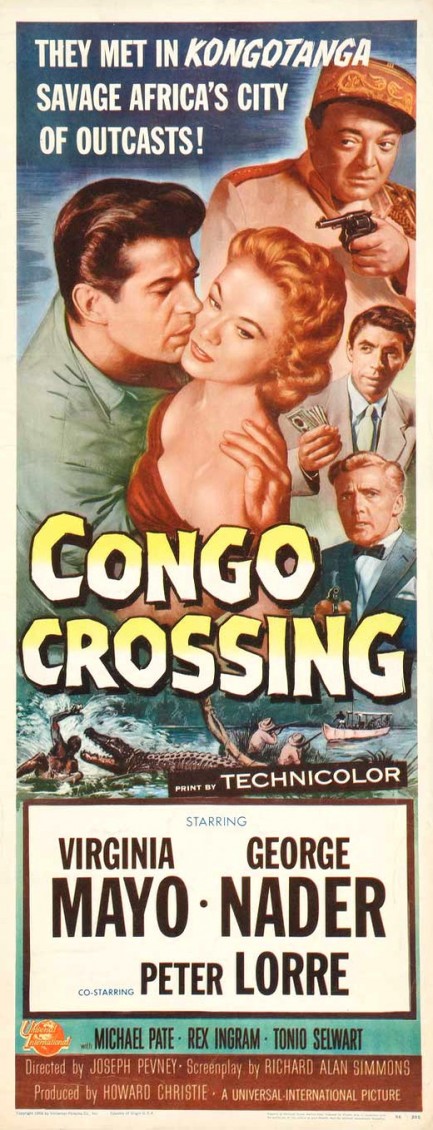
This poster for Congo Crossing has all the elements—firearms, some romantic nuzzling, and a huge crocodile. The trifecta. So we watched it, and what you get here is a Technicolor adventure set in the fictive West African land of Kongotanga, which sits geographically on the border of Belgian Congo, and is a stand-in thematically for Casablanca. Which is to say Congo Crossing uses the basic set-up of Casablanca—transitory expats and shady types in an ass-end outpost riven by local political tensions and power struggles. Virginia Mayo plays a wanted woman fleeing a murder charge she picked up on the French Riviera, George Nader plays the rakish stud who you aren't sure whether to like at first, and in the supporting cast are corrupt local kingpin Tonio Selwart, killer for hire Michael Pate, and Peter Lorre as the local chief of police. Here are some Casablanca similarities:
Expats desperate to catch the next day's plane to anywhere.
A climactic airport shootout.
A woman greatly desired by two men.
Lots of gun toting guys in tropical suits.
A comedic police official whose loyalties shift where the wind blows.
A moment when one man tells a rival it looks like the beginning of a friendship.
Peter Lorre.
We mention Casablanca as shorthand to give you an idea of the set-up, and now we'll mention The African Queen—another Humphrey Bogart classic—as shorthand to tell you what the middle of the movie becomes. Mayo, Nader, and a few others embark on a boat trip upriver to a jungle hospital. There Mayo realizes she's the target of a killer, and flees farther along the river with Nader, dealing with an ambush, a sexual predator, a swarm of terrible tse-tse flies, a sneaky croc, and a deadly illness. You've seen The African Queen, right? A couple of strong similarities there. The group faces these problems and, unlike their African helpers, come away more or less intact, then the movie disembarks from the river—and The African Queen—to shift back to Kongoblanca, er, we mean Kongotanga, where everything began.
So does a movie that starts and ends kind of like Casablanca and has something kind of like The African Queen stitched into the middle work? Not with this script and budget it doesn't. And though the cast is game and experienced, the material doesn't give them much of a chance to sparkle. We can't call the movie bad, but we certainly can't describe it as recommendable either. And going back to the jungle segment for a moment, why is it that in such films the people born and raised in Africa always get eaten while white folks like Mayo and Nader can snog in the bush and be just fine? That's a rhetorical question of course. Congo Crossing premiered today in 1956.
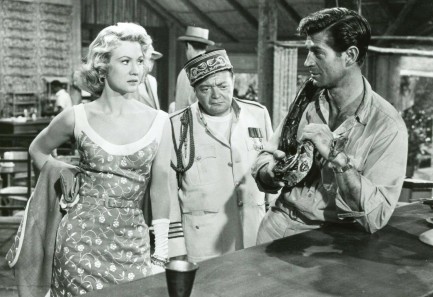 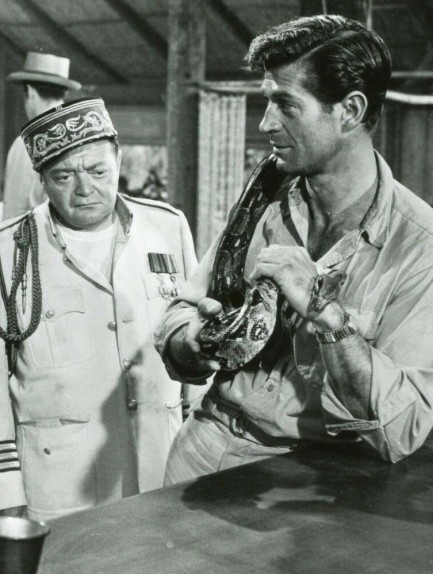 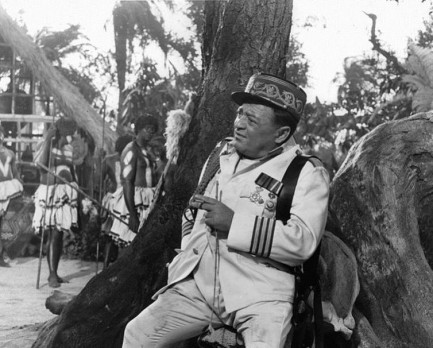 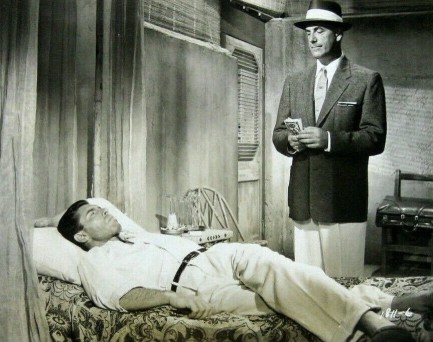 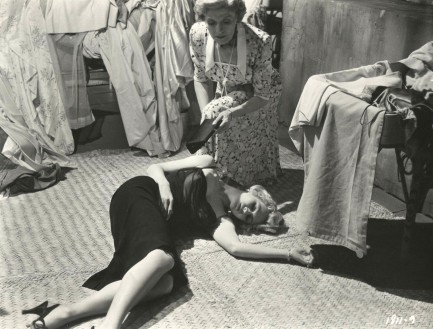 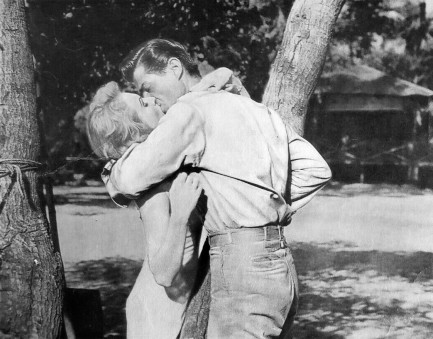 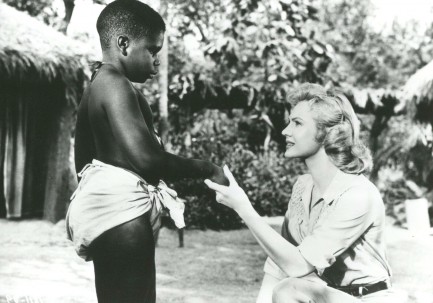 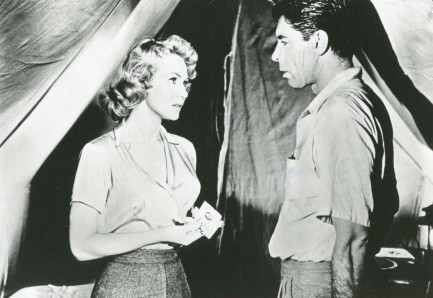 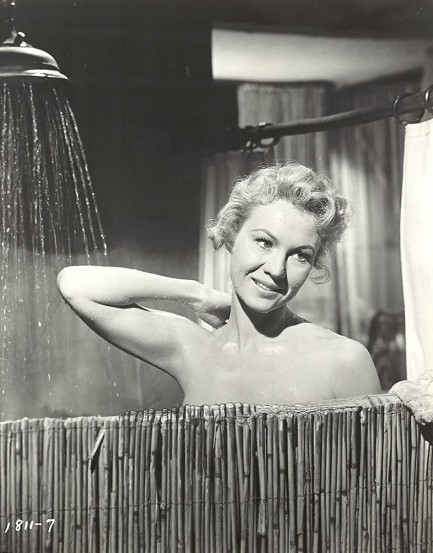 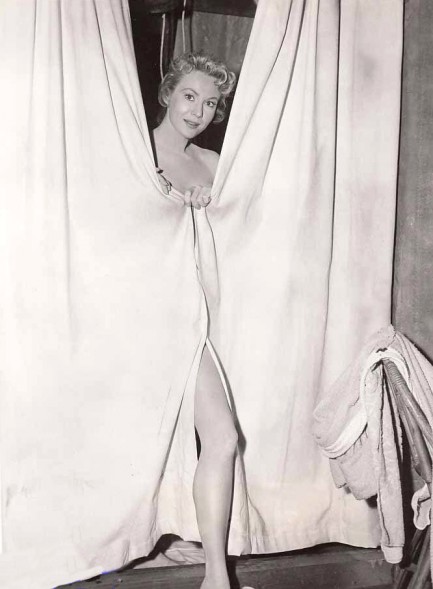 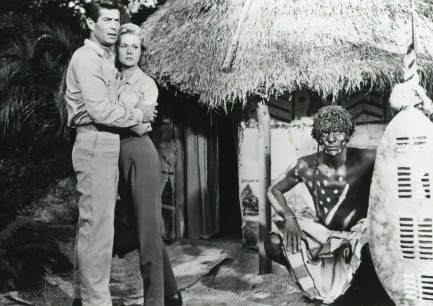 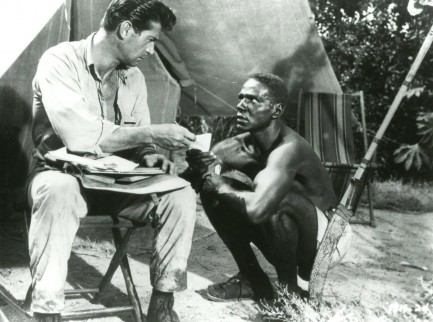 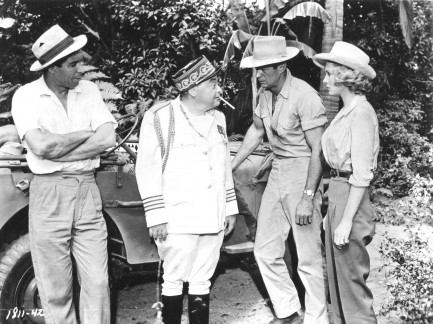 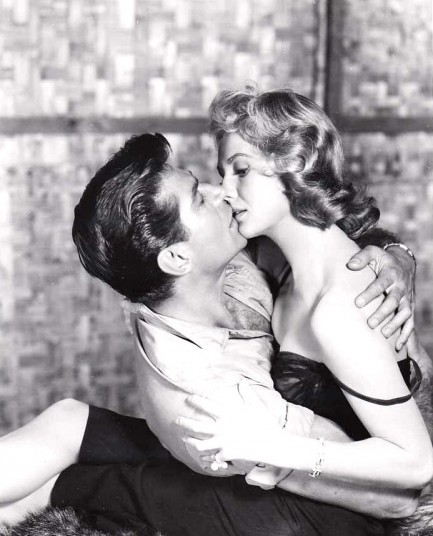 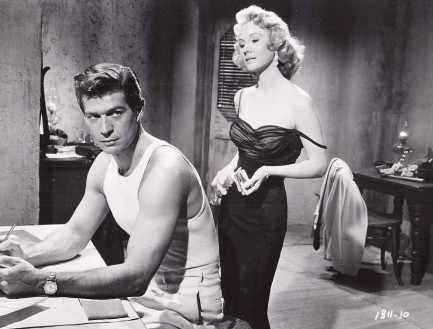  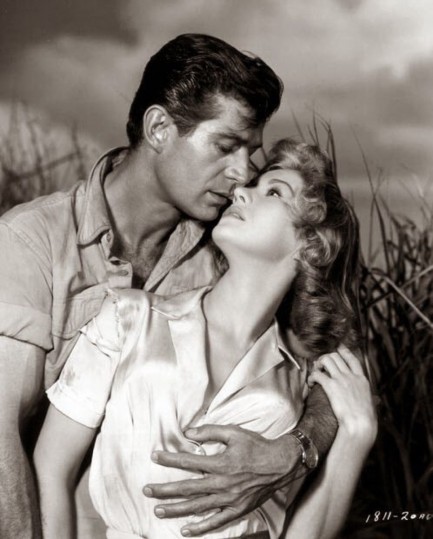 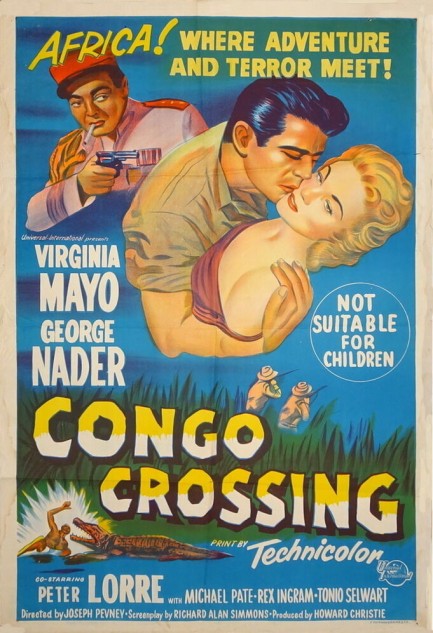
 Not with my daughter you don't. 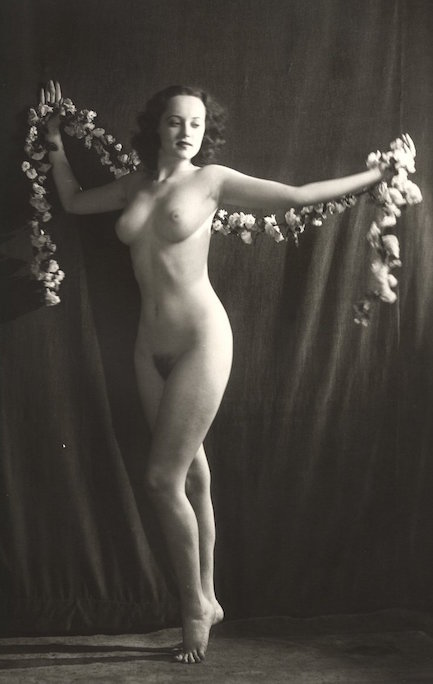
They say the apple doesn't fall far from the tree. We wonder if legendary pin-up painter and connoisseur of the nude female form Earl Moran was upset about that. We ask because that's his daughter above, Peggy Moran, posing in the altogether in this shot made by famed photographer Alfred Cheney Johnston around 1936. Did Earl and Al know each other? Well. That must have made for an interesting discussion. But what could Earl say, really? Of course, another intriguing possibility is that he never knew. Generally, models kept their early nudes secret. Marilyn Monroe changed the paradigm when her naked shots came out and she shrugged and said, “And? Pervs. So what?” We're paraphrasing.
Maybe Peggy kept her nude session quiet, but we prefer the idea of Earl and Alfred having a little tête-à-tête about it:
“But Alfred, I thought we agreed she was off-limits.”
“I know, Earl, but look at her. I'm only a flawed fifty-something human male faced with youthful feminine perfection. I mean, she's 100% f'dilf.”
“Wha... what? She's a what?”
“You know. A friend's daughter I'd...” *winks and grins*
“I'm gonna fucking kill you.”
This stuff writes itself. In any case, two years after the above shot was made Moran got her break in films and by 1940 was a regular on the silver screen, appearing in One Night in the Tropics, Drums of the Congo, and about thirty other films. Talentwise, she had the goods, as a glance at the very enjoyable goofball horror movie The Mummy's Hand will confirm. Her career hit overdrive by 1941, but it didn't last long—she got married and gave up show business to raise a family. Her last role was in 1943. Her nudes finally saw daylight sometime after that.
 That was interesting. Next time can we just do it the normal way? 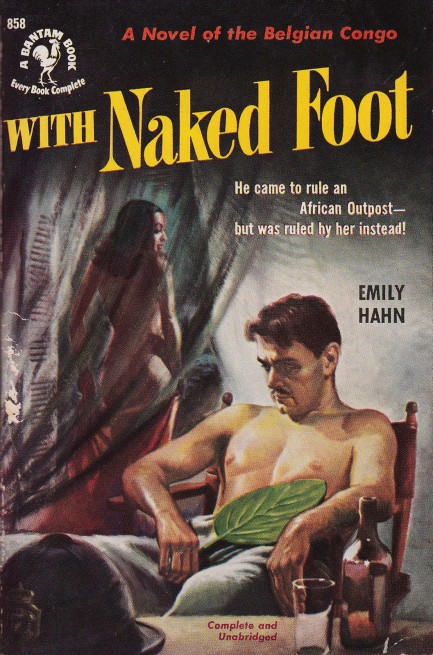
There's no festish sex or podophilia in With Naked Foot. This is actually a serious novel about whites coming to ruin in Africa, which is a crowded literary niche, but one in which Emily Hahn carved out an important place for herself. In fact, maybe the adjective “Hahnesque” should be used alongside “Hemingwayesque.” This is a person who wrote fifty-four books and more than two hundred articles and short stories, whose works were significant in romanticizing Africa and Asia for western readers, who lived in Florence and London in the mid-1920s, traveled to the Belgian Congo where she worked for the Red Cross, lived with a pygmy tribe for two years, crossed Central Africa alone on foot, and journeyed to Shanghai where she taught English for three years while becoming acquaintances with political powerhouses the Soong Sisters and the Chinese poet Zau Sinmay. With Naked Foot is, therefore, unusually well informed. It revolves around a beautiful Congolese girl named Mawa whose relationships with various lustful white men bring disaster. The reviews were rapturous, though some critics protested that it was too focused on sex. That's never a complaint you'll hear from us, though some of the usual flaws of mid-century racial fiction are evident. The cover art on this Bantam paperback was painted by an unknown, and the copyright is 1951.
 Getting there was a long and difficult journey, but now he's finally going to explore the bush. 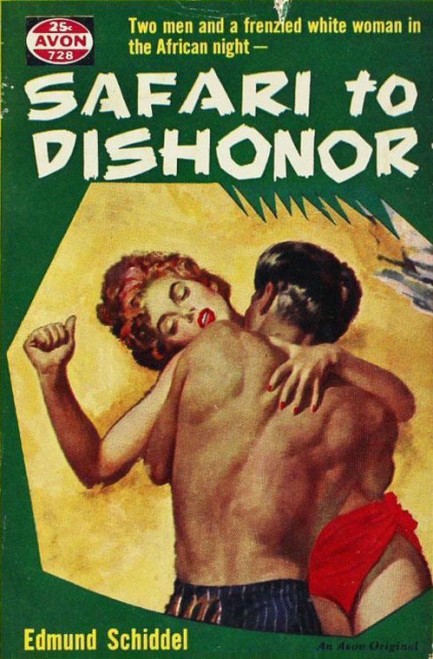
You can figure out the story here, right? The title and cover combine to sort of give it away. Bored rich girl Teresa Porter, who's married to linguist Julian Porter, is dragged on a two-year research trip to the Belgian Congo along with her hot young lover Allan, who is her husband's assistant. Literarily speaking, Africa has been the end of tougher people than these three, so you know they're going to have myriad troubles. The interracial aspect suggested by the cover blurb does not apply to lover Allan, but Edmund Schiddel adds subplots along those lines, as you'd expect from any author working in the African milieu. The copyright on this is 1956, and the art is uncredited.

|
 |

The headlines that mattered yesteryear.
2003—Hope Dies
Film legend Bob Hope dies of pneumonia two months after celebrating his 100th birthday. 1945—Churchill Given the Sack
In spite of admiring Winston Churchill as a great wartime leader, Britons elect
Clement Attlee the nation's new prime minister in a sweeping victory for the Labour Party over the Conservatives. 1952—Evita Peron Dies
Eva Duarte de Peron, aka Evita, wife of the president of the Argentine Republic, dies from cancer at age 33. Evita had brought the working classes into a position of political power never witnessed before, but was hated by the nation's powerful military class. She is lain to rest in Milan, Italy in a secret grave under a nun's name, but is eventually returned to Argentina for reburial beside her husband in 1974. 1943—Mussolini Calls It Quits
Italian dictator Benito Mussolini steps down as head of the armed forces and the government. It soon becomes clear that Il Duce did not relinquish power voluntarily, but was forced to resign after former Fascist colleagues turned against him. He is later installed by Germany as leader of the Italian Social Republic in the north of the country, but is killed by partisans in 1945.
|

|
|

It's easy. We have an uploader that makes it a snap. Use it to submit your art, text, header, and subhead. Your post can be funny, serious, or anything in between, as long as it's vintage pulp. You'll get a byline and experience the fleeting pride of free authorship. We'll edit your post for typos, but the rest is up to you. Click here to give us your best shot.

|
|



 Anglo-Egyptian Sudan, and the Belgian Congo. The expenduture must have been enormous, but the money shows—vividly. You won't be surprised to learn that people died making the film—one by being consumed by a crocodile, and the other by being trampled by a rhino. There were also numerous illnesses and accidents. And... it was all worth it! Just kidding. Thoughts and prayers.
Anglo-Egyptian Sudan, and the Belgian Congo. The expenduture must have been enormous, but the money shows—vividly. You won't be surprised to learn that people died making the film—one by being consumed by a crocodile, and the other by being trampled by a rhino. There were also numerous illnesses and accidents. And... it was all worth it! Just kidding. Thoughts and prayers.
























































































































































